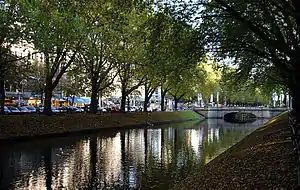Königsallee
The Königsallee (German pronunciation: [ˈkøːnɪçsˌaleː], literally "King's Avenue") is an urban boulevard in Düsseldorf, state capital of North Rhine-Westphalia, Germany. The Königsallee is noted for both the landscaped canal that runs along its center, as well as for the fashion showrooms and luxury retail stores located along its sides.
 View of the Königsallee's eastern side across the canal | |
| Former name(s) | Neue Allee, Mittelallee, Kastanienallee |
|---|---|
| Length | 3,280 ft (1,000 m) |
| Location | Stadtmitte, Düsseldorf, Germany |
| Nearest metro station | |
| North end | Elberfelder Straße |
| Major junctions |
|
| South end | Luisenstraße |
| Construction | |
| Inauguration | 1804 |
| Other | |
| Designer | Caspar Anton Huschberger |
Nicknamed Kö by the locals, the Königsallee is by far Germany's busiest, upscale shopping street.[1][2]
Location
The Königsallee is some 1 km long and lies in the district of Stadtmitte. It stretches from Hofgarten, Düsseldorf's main park, to Carl-Theodor-Straße and Luisenstraße on its Southern end. At Hofgarten, the Königsallee reaches onto Landskrone, a peninsula of the park's lake. Adjacent to Königsallee are the Altstadt, Düsseldorf's old quarter, and Schadowstraße, Germany's shopping street with the highest sales revenues.
The canal is some 31 m wide and fed by water from the Düssel, from which the city got its name. The entire boulevard is some 80 metres (260 ft) wide and may be perceived as an urban esplanade. The Eastern side of Königsallee is entirely commercial, with numerous upmarket flagship stores and block-internal shopping arcades leading to and from the boulevard. Most of the Western side is quieter, given that it predominantly has offices, bank branches and hotels. Cafés and restaurants are located on both sides.
History


By the end of the 18th century, Düsseldorf was a small Baroque town and capital of the Grand Duchy of Berg. Following the Treaty of Lunéville, the Duke was to have Düsseldorf's fortifications removed, which turned out to give room for a more generous urban plan. This plan included a Classicism esplanade, designed by architect to the court Caspar Anton Huschberger, in co-operation with landscape architect Maximilian Friedrich Weyhe and hydraulic engineer Wilhelm Gottlieb Bauer.
Canal and boulevard were completed between 1802 and 1804. Hotel Breidenbacher Hof was opened in 1812; other buildings followed shortly after. The canal which runs through the center of the boulevard is 31 metres (102 ft) wide and up to 5 metres (16 ft) deep. The canal is fed by the Düssel, which was diverted to provide the necessary water. Two iron bridges cross the canal. On the suggestion of the landscape architect, Chestnut trees (German: Kastanien) were planted along the canal and the boulevard was therefore given the name "Kastanienallee" accordingly. After an incident in 1848, when horse manure was thrown at King Friedrich Wilhelm IV, the street was renamed "Königsallee" (meaning King's Avenue) as a gesture of reconciliation.
Düsseldorf lost its independence to Prussia for most of the 19th and early 20th century, but the city remained an important international centre of the arts, and Königsallee its foremost boulevard. After 1946, with Düsseldorf's new weight as state capital of the economically most powerful state of Germany, and the city's location at the heart of the largest metropolitan region in Germany, caused the German fashion industry to consolidate Düsseldorf as one of the world’s fashion capitals. An open-air fashion show on Königsallee initiated the first Igedo Fashion Fair in 1949, which over the years grew to become one of the world's largest fashion fairs.[3] Since 1981 the biannual Düsseldorf Fashion Shows are held as Collection Premiers Düsseldorf (cpd) - primarily at Messe Düsseldorf Exhibition Centre, but showrooms throughout the city.[4]
The Northeastern section has recently been redeveloped with a 40,000 m² office and retail complex called "Kö-Bogen",[5] designed by architect Daniel Libeskind.[6] The first sections were opened in 2014.
Assortment
Many major designers have a presence on Königsallee, so that a roll call reads like a "who's who" of the international fashion industry. Products offered range from luxury fur coats to high-end electronics for audiophiles, and the gamut in between. The following list is an overview[7] of some of the most notable stores. An extended scope and range of shops, brands and services goes on other nearby streets.
Stores
|
|
Hotels
- Breidenbacher Hof
- InterContinental
 Another view of Königsalle
Another view of Königsalle - Steigenberger Parkhotel
In popular culture
The Königsallee is referred to in Herbert Grönemeyer's 1984 hit Bochum.
Places of interest nearby

- Düsseldorfer Schauspielhaus, theater
- Deutsche Oper am Rhein, opera house
- Kunstsammlung Nordrhein-Westfalen K20 and K21
- stilwerk Düsseldorf
See also
References
- Königsallee ist beliebteste Luxusmeile, Die Welt, 12 July 2010 (in German)
- 2010 survey by Jones Lang LaSalle (in German)
- Bernd Haunfelder: "Nordrhein-Westfalen, Land und Leute, 1946–2006 - Ein biographisches Handbuch", Münster, 2006, pages 52f
- showroom map by Düsseldorf Voices of Fashion Archived 2011-01-13 at the Wayback Machine, Fashion Net Düsseldorf e.V.
- Kö-Bogen Düsseldorf, die developer Projektentwicklung GmbH, Düsseldorf
- Kö-Bogen Düsseldorf Archived 2010-12-04 at the Wayback Machine, Studio Daniel Liebeskind, New York
- addresses A-Z Archived 2011-02-21 at the Wayback Machine
External links
| Wikimedia Commons has media related to Königsallee (Düsseldorf). |
- Many photos on bilderbuch-duesseldorf.de (in German)
- Königsallee interest group (in German and English)
- Igedo Company (in German and English)
- düsseldorf fashion house (in German and English)
